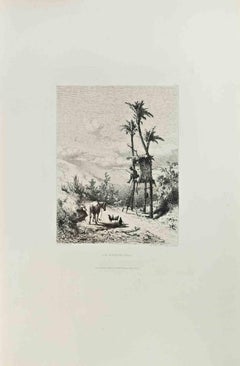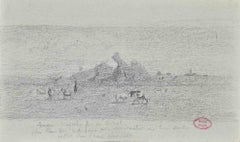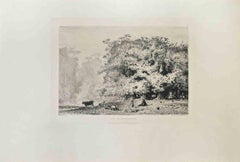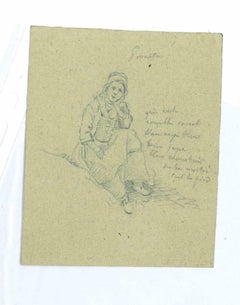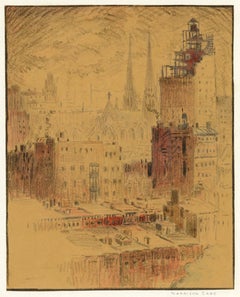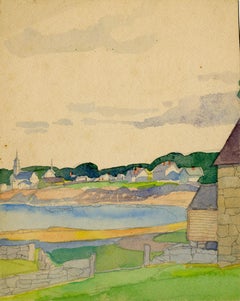Paul Huet Art
to
2
2
Overall Width
to
Overall Height
to
4
4
3
1
2
1
1
1
1
1
1
1
1
1
2
2
6
9,988
2,754
1,377
1,375
2
Artist: Paul Huet
Un Mirador (Elche) - Etching by Paul Huet - 1864
By Paul Huet
Located in Roma, IT
Etching on laid paper
Signed and inscribed in plate lower left: Paul Huet sculp.
Published by Cadart & Luquet, Éditeurs, 79 Rue Richelieu, Paris
With the blindstamp of the Société de...
Category
1860s Modern Paul Huet Art
Materials
Etching
Landscape - Drawing by Paul Huet - 19th Century
By Paul Huet
Located in Roma, IT
Landscape is a Pencil Drawing realized by Paul Huet.
Good condition included a grey cardboard passpartout (32.5x50 cm).
Stamp signed on the lower right corner.
Paul Huet (3 October 1803 – 8 January 1869) was a French painter and printmaker born in Paris. He studied under Gros and Guerin. He met the English painter Richard Parkes Bonington in the studio of Gros, where he studied irregularly from 1819 to 1822. Bonington's example influenced Huet to reject neoclassicism and instead paint landscapes based on close observation of nature. The British landscape paintings exhibited in the Salon of 1824 were a revelation to Huet, who said of Constable's work: "It was the first time perhaps that one felt the freshness, that one saw a luxuriant, verdant nature, without blackness, crudity or mannerism."[4] Huet's subsequent work combined emulation of the English style with inspiration derived from Dutch and Flemish old masters such as Rubens, Jacob van Ruisdael...
Category
19th Century Modern Paul Huet Art
Materials
Pencil
Près de Fontainebleau - Etching by Paul Huet - 1870s
By Paul Huet
Located in Roma, IT
Près de Fontainebleau is a black and white etching realized by Paul Huet (1803 –1869) in 1870s.
Titled in the lower.
Image size: 28cmx19.5cm.
Very Good condition.
Signed on the u...
Category
1870s Modern Paul Huet Art
Materials
Etching
The Maiden - Original Drawing by Paul Huet - 19th Century
By Paul Huet
Located in Roma, IT
The Maiden is an original Drawing in pencil realized in the 19th Century by Paul Huet (1803-1869).
With another drawing on the rear.
In good condition.
The artwork is depicted sk...
Category
19th Century Modern Paul Huet Art
Materials
Pencil
Related Items
Saint Patrick's Cathedral from Midtown Manhattan
Located in Middletown, NY
Graphite with watercolor and black crayon on cream wove paper mounted to board, 12 1/2 x 10 1/2 inches (318 x 267 mm), full margins. Signed in pencil on the mount. In excellent condi...
Category
Early 20th Century American Modern Paul Huet Art
Materials
Crayon, Watercolor, Graphite
Chapel and houses along a lake, New England Landscape - American School, 19th C
Located in Middletown, NY
Watercolor and pencil on buff wove watercolor paper, 10 x 8 inches (255 x 203 mm). In good condition with overall minor toning. Some watercolor paint splatters on the verso, contem...
Category
Early 1900s American Modern Paul Huet Art
Materials
Watercolor, Pencil
Children Snow Sledding in Central Park - New Yorker Cover Study
Located in Miami, FL
Hungarian/American artist/illustrator depicts a charming scene of sledding in the snow in Central Park. The work is abstract in its design as it's functional in its narrative - Unpublished New Yorker...
Category
1940s Modern Paul Huet Art
Materials
Charcoal, Ink, Watercolor, Gouache, Pencil
$15,000
H 16.85 in W 12.25 in
"Contemplation"
By Gershon Benjamin
Located in Lambertville, NJ
Jim’s of Lambertville is proud to offer this artwork by:
Gershon Benjamin (1899-1985)
An American Modernist of portraits, landscapes, still lives, and the urban scene, Gershon Benj...
Category
1920s Modern Paul Huet Art
Materials
Graphite
The Endeavour.
By Arthur John Trevor Briscoe
Located in Storrs, CT
The Endeavour. c.1935. Pencil and watercolor on watercolor board. 14 3/8 x 20 7/8. Signed in pencil, lower right; titled in pencil, verso. Housed in a subtle 23 1/2 x 36-inch light ...
Category
1930s Modern Paul Huet Art
Materials
Watercolor, Pencil
Modern Early Black and White Charcoal Artist Self Portrait Drawing
Located in Houston, TX
Modern early black and white artist self portrait by Houston artist Edsel Cramer. The work features a young portrait of the artist staring directly forward and cropped within an off-...
Category
1940s American Modern Paul Huet Art
Materials
Paper, Charcoal, Graphite
$1,500
H 18.75 in W 16.75 in D 0.5 in
The Pool of London.
By William Lionel Wyllie
Located in Storrs, CT
The Pool of London. c. 1915. Etching and drypoint. 7 7/8 x 15 7/8 (sheet 11 x 14 7/8 x 21 1/4). A rich impression with drypoint burr printed on the full sheet of simili-Japan paper. ...
Category
1910s Modern Paul Huet Art
Materials
Drypoint, Etching
Young man in a toga elegant man Latin American hyperrealist Hockney style
By Claudio Bravo
Located in Norwich, GB
Superb original drawing in coloured conté pencils, heightened with white on oatmeal coloured vergé paper by Claudio Bravo. The work was created during the artist's Moroccan period, a...
Category
1970s Modern Paul Huet Art
Materials
Conté, Laid Paper, Color Pencil
$7,500
H 30.32 in W 24.02 in D 0.4 in
Antique Victorian Watercolour of Whitby Harbour by 19th Century British Artist
By William Langley
Located in Preston, GB
Antique Victorian Watercolour of Whitby Harbour by 19th Century British Artist William Langley (1852–1922) dating back to Circa 1891
Art measures 19 x 10.5 inches
Frame measures 2...
Category
1890s Victorian Paul Huet Art
Materials
Gold
$1,223 Sale Price
25% Off
H 17 in W 25 in D 1 in
Wake on the Ferry.
By John French Sloan
Located in Storrs, CT
Wake on the Ferry. 1949. Etching. Morse catalog 313. state v. 5 x 7 (sheet 8 3/4 x 11 7/8). Edition of 350: 200 for the Art Students League and 150 for the artist. A fine impression ...
Category
1940s American Modern Paul Huet Art
Materials
Etching
A Handsome 1940s Portrait of a Seated Man by Chicago Artist, Harold Haydon
By Harold Haydon
Located in Chicago, IL
A Handsome 1940s Portrait of a Seated Man by Chicago Modern Artist, Harold Haydon (Am. 1909-1994). A wonderfully executed line drawing dating from 1946 with great character; looks ...
Category
Mid-20th Century American Modern Paul Huet Art
Materials
Paper, Graphite
$135
H 20 in W 16 in D 0.13 in
A Sensitive 1950s Mid-Century Modern Portrait of a Young Man By Harold Haydon
By Harold Haydon
Located in Chicago, IL
A Sensitive, Finely Rendered 1950s Mid-Century Modern Portrait of a Young Man By Noted Chicago Artist, Harold Haydon (Am. 1909-1994). Artwork size: 12 x 9 1/2 inches. Artwork is un...
Category
Mid-20th Century American Modern Paul Huet Art
Materials
Paper, Graphite
$385
H 16 in W 12 in D 0.13 in
Previously Available Items
Paul HUET - Copy after Rubens
By Paul Huet
Located in PARIS, FR
Paul HUET Paris, 1803 – Paris, 1869
Oil on panel 42 x 32 cm (49.5 x 41 cm with the frame)
Inscription on the verso “Paul Huet / Copy after Rubens”
The b...
Category
1840s Romantic Paul Huet Art
Materials
Oil
La Nymphe des Bois- 19th Century Oil, Nude Figure in Forest Landscape by P Huet
By Paul Huet
Located in Marlow, Buckinghamshire
Oil on panel circa 1845 by Paul Huet depicting a nude lying on a forest floor. Signed lower left. This painting is not currently framed but a suitable frame can be sourced if require...
Category
Mid-19th Century Romantic Paul Huet Art
Materials
Oil, Panel
Paul Huet art for sale on 1stDibs.
Find a wide variety of authentic Paul Huet art available for sale on 1stDibs. You can also browse by medium to find art by Paul Huet in pencil and more. Much of the original work by this artist or collective was created during the 19th century and is mostly associated with the modern style. Not every interior allows for large Paul Huet art, so small editions measuring 4 inches across are available. Customers who are interested in this artist might also find the work of Alfred Grevin, Eugène Giraud, and Pierre Segogne. Paul Huet art prices can differ depending upon medium, time period and other attributes. On 1stDibs, the price for these items starts at $77 and tops out at $339, while the average work can sell for $208.
